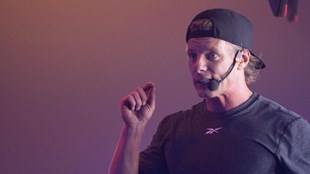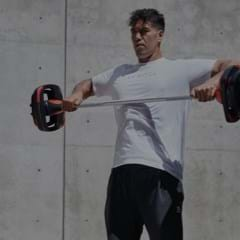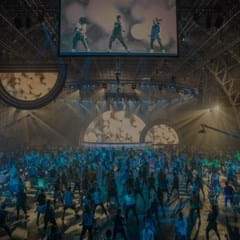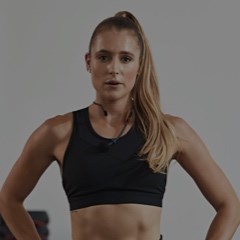Sarah Chermely, Les Mills US
“For years I solely watched the Masterclass to learn a release. It would take weeks because I’d get distracted by the clothes, lights or cues from the Presenters. One day I tried something different and it’s been a major time saver! First, I listen to the music as much as I can (while cleaning, driving, lifting weights), then watch the Masterclass while writing down choreography. The simple act of writing the choreography down cements it in my brain. Since I have usually listened to the music beforehand I know the highs and lows, which brings the whole release together much quicker! Now, I can learn BODYPUMP™ in 2 to 3 hours total, LES MILLS SPRINT™ in 30 min and BODYSTEP™ will take about 4 to 6 hours."
Justin Riley, Les Mills UK
“I have a ‘pressure practice’ idea. This is where I play the Masterclass footage with Presenter voice off and pretend to teach the track to members. I’ll move with the music and coach out loud whilst also dealing with external distractions like the dog, the TV in the background, or even answering a question from someone in the house. This helps me to determine how well I truly know the track. If I stay on track with all this happening at once then I’ve got it!
In a live class situation there are always distractions or moments of impromptu connection that will take your attention from purely teaching the choreography.
If I lose my way I’ll check the Masterclass footage and get back on track. I’ll then re-do the same practice of that track and correct the part that threw me. This is to add an extra level of realism to practicing at home.
It’s very easy to focus on just the music and moves which can give you a false sense of security that you’ve truly learnt it well enough to teach and deal with distractions.”
Ibaa Al Masri, Les Mills Middle East
“Social media-free learning! While watching the Masterclass, avoid social media: no texting, no constantly checking feeds… this time is precious and your mental efforts will clearly show up in your teaching. Don’t let Instagram affect your focus; social media can wait, that new release launch can’t!
3 things will make the learning perfect:
- Don’t get distracted by superficial things like your hair or clothing in the studio mirrors, be confident that you look great!
- Record your technique and coaching on your phone, and be brave enough to watch it even if you don’t feel like it. Self-assessment is a very effective tool for growth.
- Always keep a piece of paper to quickly write down which part you need to focus on while teaching. Never assume that you’ll remember to revisit this point, you probably won’t!
For future reference, add your own personalized title next to the tracks on your choreography notes. We all know that BODYATTACK™ track 3 is about fun, but what about writing ‘3 Identical sets’, or ‘32 Jacks at the end’? In BODYPUMP try ‘6 Rows’ for track 4, for track 8 try ‘7 Rear Delts’. These small titles will be a great help when you revisit older releases. The last thing you want to do is that Finale move when the music is still on… yikes!
Also – the glossary section is not just for beginners; this section is being updated frequently. Revisit it every time you get your hands on the release and use it to refresh your coaching cues.
Just remember, if you still go off the beat while practicing, or you forget what the next move is, this is likely to happen on the stage, so an error-free practise class is an error-free live class.”
Mathilda Björck, Les Mills Nordic
“I always watch the Masterclass first to get a feel for the release, see the moves and hear the coaching. Then I listen to the music and do the moves, practicing them physically to get them in my body. I read the Track Focus to understand the tracks and I use the choreography notes when I practice. When I have this routine, the coaching comes naturally and it’s so much easier to prepare.”
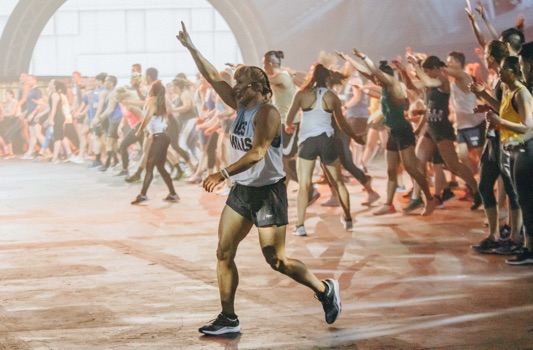
Matt Thraxton, Les Mills China
Music
“I always start with the music. I try to listen to the release as often as possible: in the shower, in the car, on the train, working out, making dinner, doing laundry. Certain lyrics, rhythms, patterns, instruments and musical landmarks will start to pop out for me. I know that the better I know the music, the more natural and relaxed I will feel when I teach. I usually listen to the release a few times in sequence to get a feel for the flow of that particular workout, and then I’ll have a playlist of each new release on shuffle to test my learning of the individual tracks.”
Choreography
“Secondly, I print off the choreography notes and use highlighter pens to color-code blocks of work and patterns. This makes learning the choreography quicker, easier and helps cement the learning so it becomes second nature when I then begin to teach. I also scribble lots of hints and tips and notes on the page such as musical landmarks, tricky transitions, coaching points, time codes: anything which helps my learning and gives me the ability to highlight unique points of difference in this release. This practise also gives me a great review document for when I go back to teaching these tracks later down the line.”
Music (again)
“Thirdly, I will go back to listening to the music, but this time running through the choreography and visualizing cueing and coaching in my head. This helps cement the learning, and gives me confidence that I know the release really well, so when I teach I don’t have to think about choreography, and the musical feel comes through naturally.”
Ramsey Clark Amaba, Les Mills Middle East
“First, I play the release on repeat for two to three days to familiarize myself with the music.
The next step is to learn the whole thing, and practise in front of the mirror. It’s even better if you have someone else you can practise with! It makes it more fun and can help identify the performance moments of the track.
I always make sure I take breaks where I listen to other music eg relaxing music, sounds of the forest, meditation music etc. This helps me to clear my mind. I might also have a rest day between learning so I’m fresh when I come back to it.”
Eric Kouka, Les Mills US
“BODYPUMP 113: When practicing at home I've found it helpful to learn the pattern blocks first, then place them into the music.
“For example, the Back Track can be a bit tricky with sets 2 and 4 having a 2/2 Deadrow, Deadlift and High Pull combo, and 4x Clean & Presses. While sets 3 & 5 have a Double Deadrow to start with followed by the combo, then 8x Clean & Presses.
“Approaching each track in a smaller ‘set by set’ fashion helps me nail down the NETT changes. Then all I have to do is put those smaller sets together. That way, if I'm having trouble in a particular place or transition it's not as overwhelming. I've got the rest of it so I just need to focus on that 10-20 second problem area. Following the music with the choreography notes helped a lot to make them stick.
“RPM 86: Most of the release is pretty straightforward and has repeating blocks of work. Especially tracks 3, 5, and 6. However, tracks 2 and 4 is where things get wild! They both have rapid transitions and lots of Pace, Resistance and Position (P.R.P.) changes. Know. The. Music. The music will tell you what to do but as Instructors we need to pre-cue the quick PRP shifts so the class can get there on the rhythm. There are a bunch of changes so cueing will need to be to the point (in the fun RPM way).”

Amany Wen, Les Mills China
"Top 3 learning tips
- Watch the Masterclass video
- Listen to the music
- Print off the choreography notes and write teaching tips and ideas on the notes.
Top 3 teaching tips
- Keep coaching simple in the first week, to ensure your members can follow successfully
- In week two begin to add more layer two cues to build on the foundation from week one
- In week three, start to deliver more education.”
Amal Fatta, Les Mills Middle East
“I learn each program individually so I’m not getting confused between them. I’ll learn the whole of BODYCOMBAT from start to finish before I start on BODYBALANCE.
To learn the release:
- Listen to the music, my best time to listen to the music is in the car
- Google the lyrics and try to sing the song. This helps me to match my voice to the feel of the music.
- If there’s a song I’m not immediately connecting with, I’ll work on creating a relationship with the lyrics, the melody or the rhythm.I’ll then play the Masterclass and will repeatedly physically practise the first track.
- I’ll then do the same thing with the second track and so on.
To teach the new release:
In the first two classes I’ll focus on introducing the new moves and offering all the different options. I’ll allow my participants some time to form their own relationship with the music and new moves.”
Pedro Zhai, Les Mills China
- “Watch the Masterclass a few times, paying close attention to the technical details, including the beginning and ending of each track.
- Practice in front of the mirror so you can role model the Masterclass presentation. The aim is to create muscle memory of the movements so that demonstrating correct technique in class comes naturally.
- Study the choreography and listen to the music to look for patterns and similarities, as well as identifying what is unique for that particular release.”
Nadia Hassan, Les Mills US
“I am a very visual learner so when I get a new release, I print out the choreography notes and highlight every block of work that is similar. In BODYCOMBAT, it's the A, B, C, etc. In BODYPUMP, I highlight the blocks of work 1, 2, 3, that are similar in the same colors. This way, when I'm teaching, I can visually see the colors. I know that in the Back Track there are two green sets before two blue sets.”
Adam Gripenblom, Les Mills Nordic
“For learning THE TRIP, step one, I always listen to the music for a few days to get a feel for the tracks and the release as a whole. Step two, I go through the notes and make my own draft and extract ONE THING from the TRACK TIP to make sure I have a clear focus. Step three, I watch each track separately with the notes, first with the presenter voices on and then just visually; this helps me to memorize the choreography and listen to the specific coaching etc. that is related to the TRACK TIP. Once I know the choreography, I run the full Masterclass in the studio with full visuals and from there I add on EXTERNAL OBJECTIVES for each block and plan my coaching based on what I want my participants to experience and make sure that it all links back to the TRACK TIP.”


